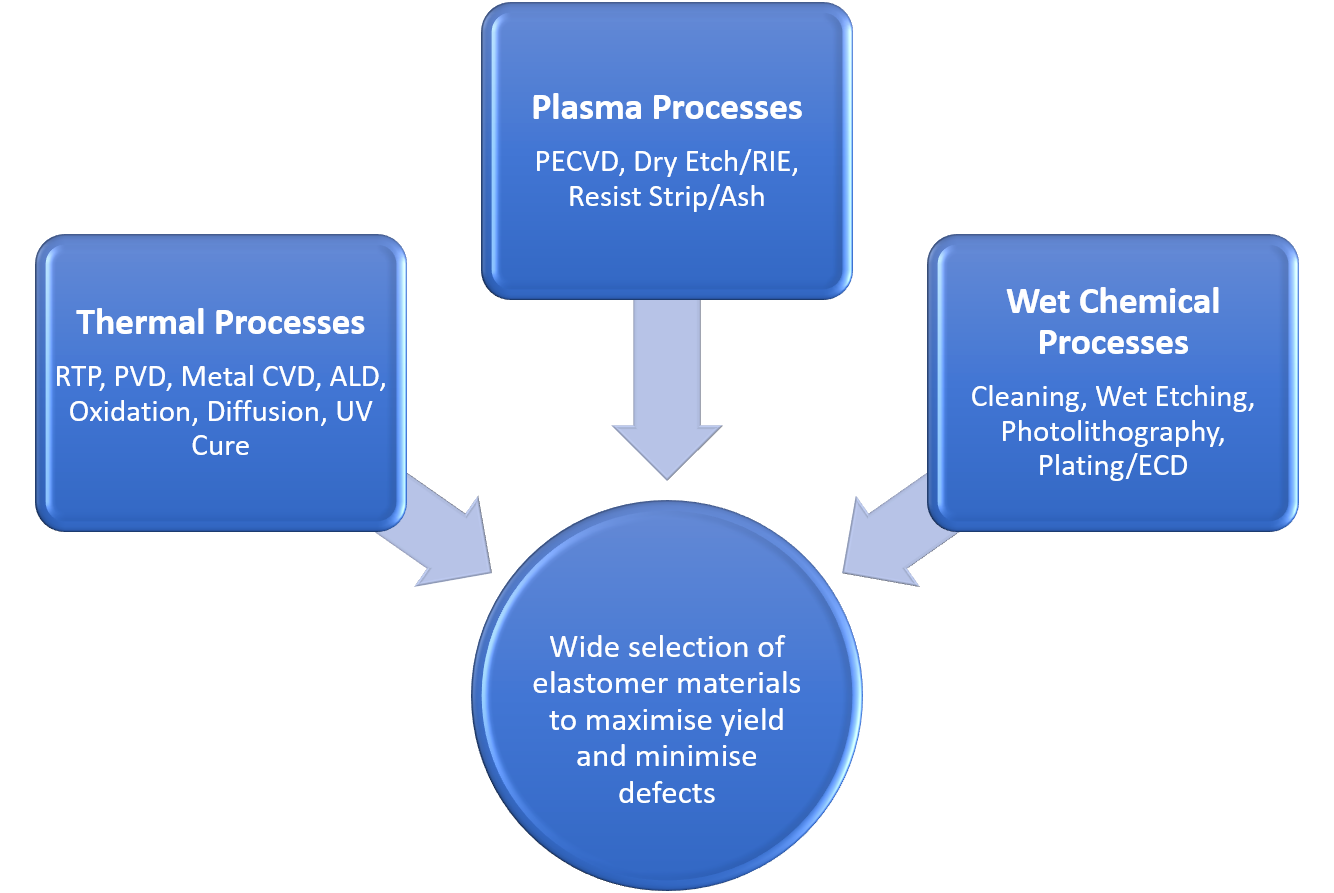Thermal Process
Semiconductor Manufacturing – Thermal Process
The term ‘thermal process’ covers a broad scope of installations. These installation temperatures are usually higher than Plasma Processes and can go up to +300°C. In addition, thermal-based installations require not only sealing materials with a particular chemical resistance demands but also ones with good mechanical features and low compression set.
Thermal Processes include:
- Atomic Layer Deposition (ALD)
- Low-Pressure Chemical Vapour Deposition (LPCVD)
- Sub Atmospheric Chemical Vapour Deposition (SACVD)
- Rapid Thermal Processing (RTP)
- Metal Chemical Vapour Deposition
- Oxidation
- Annealing
In these processes, the wafers and the machinery that surrounds them are heated to extremely high temperatures. These processes frequently include the use of ozone, oxygen or a blend of ozone and high energy UV radiation. With thermal deposition, the high temperatures help in the uniformity of the coating thickness.
Thermal Process Applications
A lot of applications are very similar to those listed in Plasma Process, however thermal processes generally have higher application temperatures. For these types of applications, adequate elastomer groove design turns out to be even more crucial. High application temperatures lead to large thermal expansion for Perfluoroelastomers. To accommodate this thermal expansion, the volume of the groove design must be adequate. Otherwise, the Perfluoroelastomers seals will overfill the groove, extrude and consequently deteriorate in the application.
Material Requirements in the Thermal Process – Perfluoroelastomers
The primary consideration in elastomer selection for these processes is high-temperature resistance. For a lot of these installations, elastomers filled with standard fillers such as carbon black are used. These rubbers are not exposed to hostile etching demands as it is observed in plasma processes. In thermal processes, the elastomers need to endure high temperatures and preserve sealing force following exposure to high-temperature cycling, which is extremely harsh on elastomers and accelerate the loss of sealing force (compression set). The best resistance to loss of sealing force is provided by using carbon black fillers.
Another crucial factor to take under consideration is minimal outgassing at high temperatures in order to prevent contamination of the wafer surface. The lowest outgassing at high temperatures is executed by Perfluoroelastomers. The high application temperatures may be obtained by a number of different methods, i.e high-temperature lamps. In these kinds of installations, specific FFKM material products are recommended for the best performance.

The below table points out compatible and recommended elastomer material grades for a given application. Primary grades are adjusted in the direction of critical process/tool placements.
| PROCESS/APPLICATION | TEMPERATURE RANGE | PROCESS MEDIA | PRIMARY MATERIALS | COMPATIBLE MATERIALS |
| Metal CVD ALD LPCVD | 25°C – 300°C (77°F – 572°F) | Organic precursors, WF6, TiCl4, SiH4, SiHCl3, SiH2Cl2, SiCl4, Ar, N2, H2, NH3, HF, HCl, F2, Cl2, CIF3, NF3, H2O vapour, O2, O3 | MBMS1108 | MBMS0825, MBMS0021 REV2 |
| SACVD | 25°C – 300°C (77°F – 572°F) | TEP, TEBO, TEOS, O3, O2, N2, NF3 | MBMS1108, MBMS1040 | MBMS0825, MBMS0021 REV2, MBMS0245 |
| Oxidation Diffusion | 100°C – 300°C (212°F – 572°F) | N2, O2, H2O, POCl3, BBr3, PH3, B2H6, HCl, Cl2 | MBMS1108, MBMS0245 | MBMS1040, MBMS0825, MBMS0021 REV2 |
| RTP and Thermal Oxidation | 100°C – 300°C (212°F – 572°F) | IR radiation, O2, Stream | MBMS1040, MBMS0021 REV2 | MBMS0245, MBMS0825 |
| UV Cure | 100°C – 300°C (212°F – 572°F) | N2, Ar, O2, O3 | MBMS0245, MBMS0825 | MBMS0729 |
If you require further information regarding our range of products and/or services, please contact a member of the team.
E & OE.